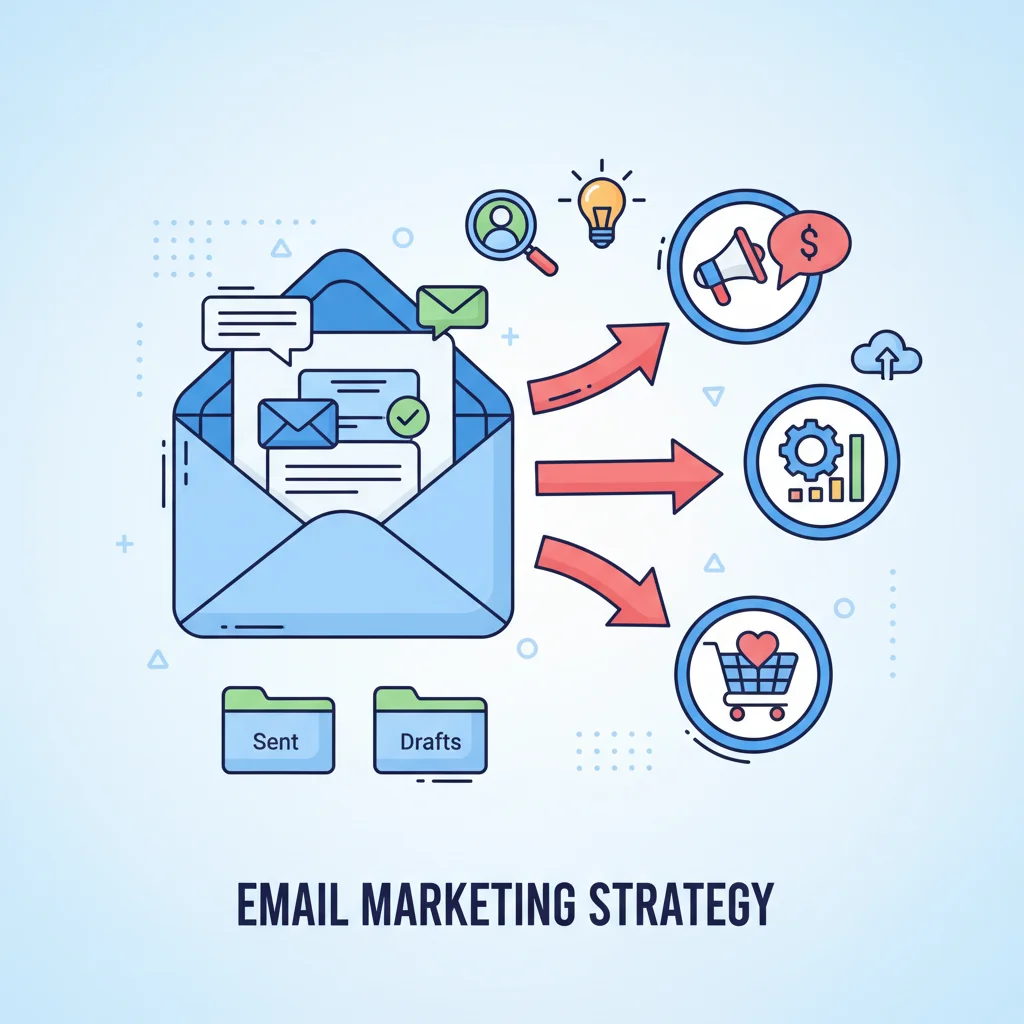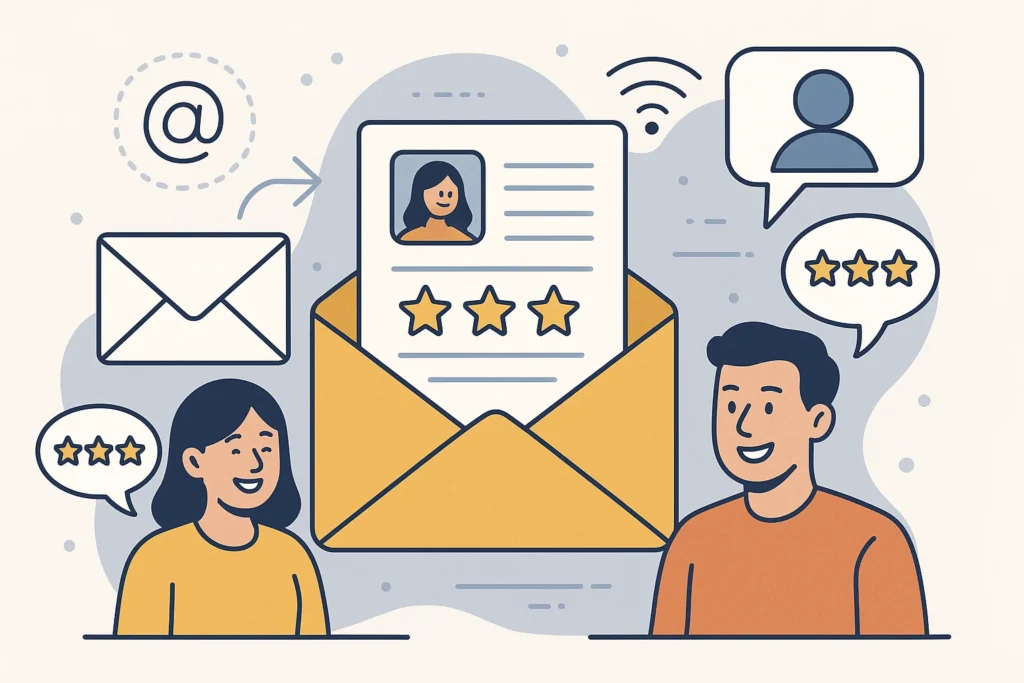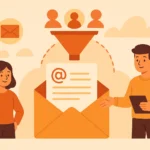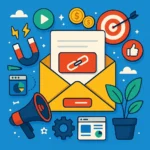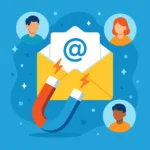Now Reading: Email Marketing for Small Business: Your Complete Startup Guide
-
01
Email Marketing for Small Business: Your Complete Startup Guide
Email Marketing for Small Business: Your Complete Startup Guide
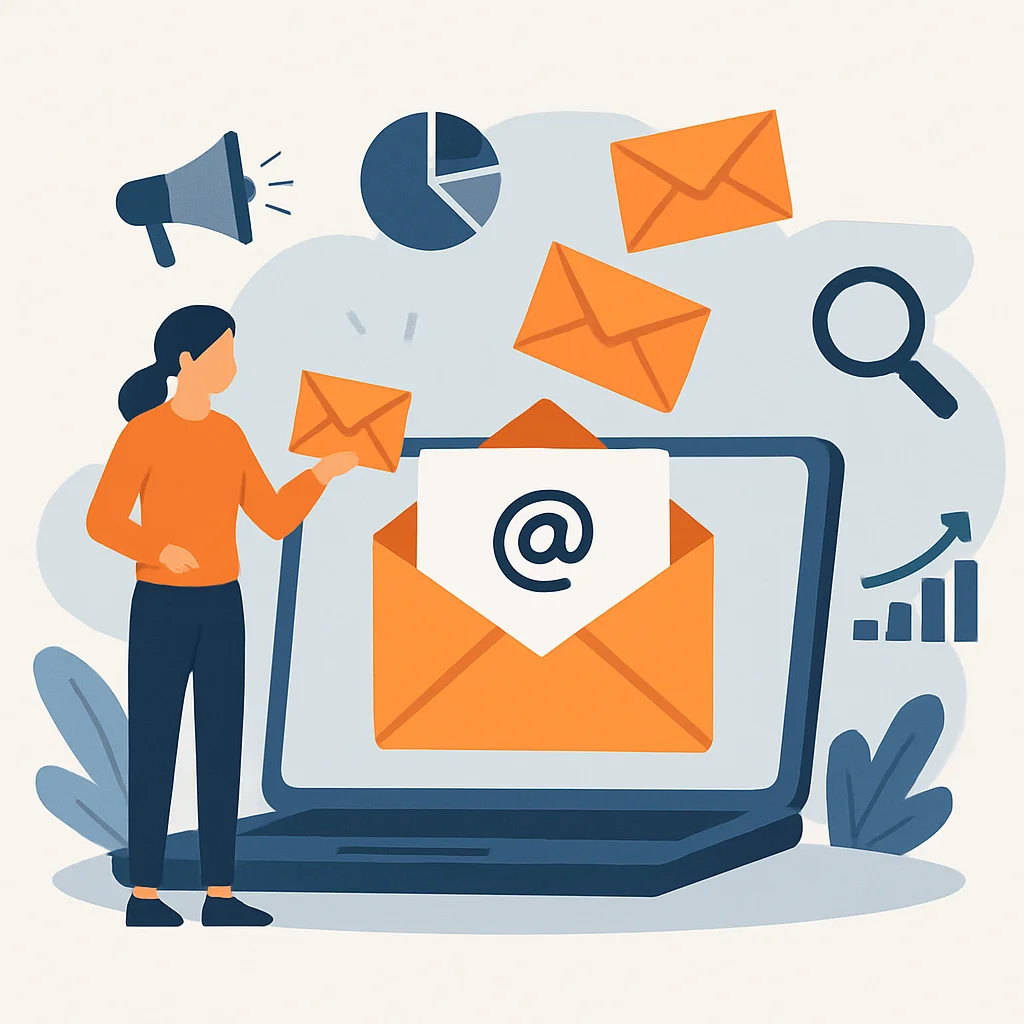
You’ve built your small business from the ground up. Your products are amazing. Your service is stellar. But something’s missing – your customers aren’t coming back as often as they should, and new leads are expensive. Starting email marketing for your small business could be the missing piece. I’ve helped dozens of businesses just like yours transform their customer relationships and boost sales through strategic email campaigns. And today, I’m going to show you exactly how to do it yourself.
Key Takeaways
How to start email marketing for your small business?
- Choose an email service provider that fits your budget and needs (MailChimp, ConvertKit, etc.)
- Build your email list through website sign-up forms, lead magnets, and in-store collection
- Create a simple welcome sequence to engage new subscribers immediately
- Plan content that provides value while promoting your products/services
- Start with a consistent schedule you can maintain (weekly or bi-weekly)
- Don’t overthink it! Even a basic email strategy beats having none at all
Getting Started With Email Marketing For Small Business
Let’s face it-email marketing can seem overwhelming when you’re already juggling a million things as a small business owner. But here’s the truth: it’s one of the most powerful tools you have, and it doesn’t have to be complicated.
I’ve worked with hundreds of small businesses, and the ones who implement even basic email marketing consistently outperform those who don’t. Why? Because email gives you direct access to people who’ve already shown interest in what you offer.
Before we dive into the nitty-gritty, let’s address the elephant in the room: yes, email marketing still works amazingly well. Despite what you might have heard about “email being dead,” the data shows the opposite. Email marketing continues to deliver the highest ROI of any digital marketing channel-period.
Why Email Marketing Matters For Small Businesses
Unlike social media platforms where you’re fighting against algorithms and competitors for attention, email gives you a direct line to your customers’ inboxes. Here’s why that matters:
- You own your email list – Social platforms can change rules or disappear, but your email list belongs to you
- Higher conversion rates – Email marketing averages 2.5-5% conversion rates compared to 1.3% for social media
- Cost-effective – You can start for free or very low cost with basic email tools
- Targeted communication – Send different messages to different customer segments
- Builds relationships – Regular emails keep your business top-of-mind
Small businesses actually have an advantage with email marketing. Your communications can be more personal, authentic, and directly relevant to your audience. People buy from businesses they feel connected to, and email helps build that connection.
Choosing The Right Email Marketing Platform
Picking an email service provider (ESP) is your first big decision. There are tons of options out there, from free to premium, and the “best” one depends on your specific needs.
For most small businesses just starting email marketing, I recommend looking for:
- Easy-to-use interface (you don’t need a tech degree)
- Affordable pricing that scales with your list size
- Basic automation capabilities
- Decent template selection
- Good deliverability rates (emails actually reaching inboxes)
Top Email Marketing Platforms For Small Businesses
MailChimp
- Free for up to 2,000 contacts and 10,000 sends per month
- Super user-friendly with drag-and-drop editor
- Great for beginners with limited tech skills
- Decent automation features on paid plans
ConvertKit
- Designed specifically for creators and small businesses
- Excellent deliverability rates
- Strong automation capabilities
- More text-focused (great for relationship building)
- Free plan for up to 1,000 subscribers
Constant Contact
- Very user-friendly interface
- Good customer support (phone, chat, email)
- Solid reporting features
- 60-day free trial
Sendinblue
- Generous free plan (unlimited contacts, up to 300 emails daily)
- Strong automation features even on lower tiers
- SMS marketing integration
- Good for international businesses
Flodesk
- Flat-rate pricing regardless of list size
- Beautiful templates
- Super intuitive interface
- Perfect for visually-oriented businesses
I personally started with MailChimp because their free plan gave me room to grow, but switched to ConvertKit as my business expanded because their automation features better suited my needs.
Don’t get stuck in analysis paralysis! Most platforms offer free trials or free plans to start. Pick one, test it out, and you can always switch later if needed.
Useful Articles:
Building Your Email List From Scratch
You can’t do email marketing without… well, emails. Building your list is an ongoing process, not a one-time task. Here’s how to start collecting emails ethically and effectively:
Create Compelling Opt-in Forms
Your website should have multiple opportunities for visitors to join your list. But simply saying “subscribe to our newsletter” isn’t gonna cut it.
Instead, clearly communicate the value they’ll get:
- “Get 10% off your first order”
- “Join 5,000+ pet owners getting weekly training tips”
- “Receive our exclusive small business resource guide”
Place sign-up forms in these high-converting locations:
- Homepage (above the fold if possible)
- End of blog posts
- Pop-ups (timed or exit-intent)
- Footer of every page
- Checkout page
Develop Irresistible Lead Magnets
A lead magnet is something valuable you give away in exchange for an email address. The best lead magnets solve a specific problem for your ideal customer.
Effective lead magnet ideas for small businesses:
- PDF guides or checklists
- Mini email courses
- Discount codes
- Free consultations
- Templates or worksheets
- Video tutorials
- Quizzes with personalized results
For my home decor business, I created a “Room Refresh Checklist” that converts at 42%-way better than my generic newsletter signup at 2%.
Offline Collection Methods
Don’t forget about collecting emails in person! If you have a physical location or attend events, consider:
- Point-of-sale collection (with clear permission)
- QR codes linking to signup forms
- Business card fishbowls for giveaways
- Text-to-join services
- Event registration forms
Always, always, ALWAYS get explicit permission before adding someone to your list. Not only is it the law in most places (looking at you, GDPR and CAN-SPAM), but sending emails to people who didn’t ask for them is a waste of your time and money.
Creating Your Email Marketing Strategy
Before you send a single email, you need a basic strategy. Nothing fancy-just answers to these key questions:
- What are your goals? (Sales, engagement, education, etc.)
- How often will you email your list?
- What types of content will you share?
- How will you measure success?
Types Of Emails Your Small Business Should Send
Different emails serve different purposes. A well-rounded email program includes:
Welcome Emails
These have an average open rate of 50-60%-that’s HUGE! Your welcome email (or series) should:
- Thank subscribers for joining
- Deliver any promised lead magnets
- Set expectations for future emails
- Include a small call-to-action
- Show your brand personality
Promotional Emails
These directly promote your products or services:
- New product announcements
- Sales and special offers
- Limited-time promotions
- Seasonal campaigns
Nurture/Value Emails
These build relationships without directly selling:
- Educational content
- Tips and how-tos related to your industry
- User-generated content
- Behind-the-scenes looks at your business
- Customer stories
Transactional Emails
These are triggered by customer actions:
- Purchase confirmations
- Shipping notifications
- Appointment reminders
- Account updates
Re-engagement Emails
These target subscribers who haven’t opened or clicked in a while:
- “We miss you” messages
- Special comeback offers
- Requests for feedback
- Last-chance notices before removal
Creating An Email Calendar
Consistency beats perfection when it comes to email marketing. Create a simple calendar that outlines:
- Email send dates
- Email types/themes
- Key promotional periods
- Content deadlines
Even a basic plan like “promotional email on Tuesdays, value email on Fridays” will keep you on track. I use a simple Google Sheet to map out my email content a month in advance.
Crafting Emails That Get Opened And Read
Now for the fun part-actually writing emails that people want to open! The three most important elements are:
Subject Lines That Grab Attention
Your subject line is like the headline of a newspaper-if it doesn’t grab attention, nothing else matters. Some proven approaches:
- Create curiosity gaps: “The weird trick that doubled our sales”
- Use numbers: “5 ways to save time on bookkeeping”
- Ask questions: “Is your website making this costly mistake?”
- Add urgency: “Last day to save 20% storewide”
- Make it personal: “John, your custom quote is ready”
Avoid ALL CAPS, excessive punctuation!!!, or misleading clickbait. These might get opens once, but they destroy trust.
I’ve found that subject lines between 4-7 words typically perform best for my audience. Test different approaches to see what works for yours.
Email Design Best Practices
Keep these design principles in mind:
- Mobile-first: Over 60% of emails are opened on mobile devices
- Clean layout: Plenty of white space, clear hierarchy
- Consistent branding: Use your brand colors, fonts, and voice
- Focused message: One primary call-to-action per email
- Scannable content: Short paragraphs, bullets, subheadings
- Optimized images: Compressed, with alt text for accessibility
For most small businesses, simpler is better. You don’t need fancy designs-plain-text emails often outperform heavily designed ones for engagement and conversions.
Writing Email Copy That Converts
The actual words in your email matter tremendously. Here’s what works:
- Write conversationally, like you’re talking to ONE person
- Focus on benefits, not features
- Tell stories that illustrate your points
- Use “you” more than “we” or “I”
- Include clear, compelling calls-to-action
- Keep paragraphs short (2-3 sentences max)
A simple formula that works for most promotional emails:
- Address a problem/pain point
- Introduce your solution
- Explain key benefits
- Provide proof (testimonials, results, etc.)
- Make an offer with clear next steps
- Add urgency or scarcity if applicable
For my business, I’ve found that emails with personal stories get 30% higher click-through rates than straight promotional messages. People connect with people, not businesses.
Useful Articles:
Setting Up Automated Email Sequences
Email automation is like having a sales team that works 24/7. Even the simplest automations can drive significant results.
Essential Automated Sequences For Small Businesses
Welcome Sequence
Triggered when someone joins your list:
- Email 1: Welcome + deliver lead magnet (immediate)
- Email 2: Introduce your business story (day 2)
- Email 3: Share valuable content/tips (day 4)
- Email 4: Introduce products/services (day 6)
- Email 5: Special offer for new subscribers (day 8)
Abandoned Cart Sequence
Triggered when someone adds items to cart but doesn’t purchase:
- Email 1: Reminder about items (1-2 hours later)
- Email 2: Address common objections (24 hours later)
- Email 3: Offer incentive to complete purchase (48 hours later)
Post-Purchase Sequence
Triggered after someone buys:
- Email 1: Order confirmation (immediate)
- Email 2: Tips for using the product (3 days later)
- Email 3: Request for feedback/review (7 days later)
- Email 4: Related product recommendations (14 days later)
Re-engagement Sequence
Triggered when subscribers haven’t opened emails in 60-90 days:
- Email 1: “We miss you” message
- Email 2: Request for feedback
- Email 3: Special offer to come back
- Email 4: Last chance before removal
Setting Up Your First Automation
Most email platforms make automation fairly simple:
- Define the trigger (what starts the sequence)
- Set the timing for each email
- Create the content for each email
- Establish any conditions or branches
- Activate and monitor
Start with just one automation-I recommend the welcome sequence since it makes an immediate impression on new subscribers. You can add more complex automations as you grow.
Segmenting Your Email List For Better Results
Sending the same email to everyone on your list is like shouting in a crowded room. Segmentation lets you whisper directly in each person’s ear.
Basic Segmentation Strategies
Even small businesses can implement these simple but effective segments:
By Purchase History
- First-time customers vs. repeat customers
- High-value vs. low-value customers
- Product category preferences
- Recent vs. lapsed customers
By Engagement Level
- Active (opened or clicked in last 30 days)
- Semi-active (opened in last 90 days)
- Inactive (no opens in 90+ days)
By Lead Source
- Website visitors
- Social media followers
- In-store customers
- Event attendees
By Demographics/Interests
- Location
- Age/gender (if relevant)
- Stated preferences
- Quiz or survey responses
Implementing Segmentation
Most email platforms allow you to segment based on:
- Subscriber data (info they provided when signing up)
- Behavioral data (how they’ve interacted with previous emails)
- Purchase data (what they’ve bought or browsed)
Start with 2-3 basic segments and expand as you learn more about your audience. For example, I segment my list by product interest and send different content to my “home decor enthusiasts” versus my “DIY project lovers.”
Optimizing Your Email Performance
The beauty of email marketing is that you can continually improve based on data. Here’s how to optimize your efforts:
Key Metrics To Track
Focus on these essential metrics:
- Open rate: Percentage of recipients who open your email
- Click-through rate (CTR): Percentage who click on links
- Conversion rate: Percentage who complete your desired action
- Unsubscribe rate: Percentage who opt out
- Revenue per email: Total revenue generated divided by emails sent
Industry benchmarks are useful, but your best comparison is against your own previous performance.
A/B Testing For Continuous Improvement
A/B testing (splitting your audience to test different versions) helps you improve over time. Test one element at a time:
Subject Lines
- Length (short vs. long)
- Personalization (with/without name)
- Questions vs. statements
- With/without emojis
Send Times
- Day of week
- Time of day
- Frequency
Email Content
- Short vs. long copy
- Different calls-to-action
- Image-heavy vs. text-focused
- Different offers or incentives
I once increased my open rates by 15% simply by testing different subject line styles. My audience responds better to question-based subject lines than statement-based ones-something I never would have known without testing.
Deliverability Best Practices
All your efforts are wasted if your emails land in spam folders. Maintain good deliverability by:
- Regularly cleaning your list of inactive subscribers
- Using double opt-in to confirm subscription interest
- Avoiding spam trigger words in subject lines
- Authenticating your domain with DKIM, SPF, and DMARC
- Maintaining engagement with valuable content
- Following email laws like CAN-SPAM, GDPR, and CCPA
Most email service providers handle the technical aspects, but maintaining a healthy, engaged list is your responsibility.
Useful Articles:
Email Marketing Tools And Resources
Beyond your main email service provider, these tools can enhance your email marketing:
Email Design Tools
- Canva – Templates and graphics for non-designers
- BEE Free – Drag-and-drop email editor
- Really Good Emails – Inspiration gallery of great emails
Subject Line Tools
- CoSchedule Headline Analyzer – Scores your subject lines
- Send Check It – Spam checking and subject line testing
Content Creation Tools
- Hemingway App – Makes your writing clear and concise
- Grammarly – Catches grammar and spelling issues
- Unsplash – Free stock photos for email content
Analytics Tools
- Google Analytics – Track email traffic to your website
- Hotjar – See how users interact with your landing pages
- UTM.io – Create tracking links for your emails
I keep it simple with just a few tools: my ESP (ConvertKit), Canva for graphics, and Google Analytics for tracking. You don’t need a complicated tech stack to get results.
Legal Considerations For Email Marketing
Email marketing comes with legal obligations you can’t ignore:
CAN-SPAM Act Requirements (US)
- Include your physical address in every email
- Provide a clear way to unsubscribe
- Honor opt-out requests promptly
- Use accurate header information and subject lines
GDPR Compliance (EU)
- Obtain explicit consent before adding to your list
- Clearly explain how you’ll use their data
- Document when and how consent was given
- Provide easy access to privacy policies
- Honor “right to be forgotten” requests
CCPA/CPRA Compliance (California)
- Disclose what personal information you collect
- Allow consumers to opt out of data sales
- Respond to consumer requests about their data
Most email service providers build compliance features into their platforms, but ultimately, legal compliance is your responsibility. When in doubt, consult with a legal professional.
Integrating Email With Your Overall Marketing Strategy
Email marketing shouldn’t exist in isolation. It works best when integrated with your other marketing channels:
Website Integration
- Place signup forms strategically throughout your site
- Create landing pages specifically for email campaigns
- Use exit-intent popups to capture leaving visitors
- Retarget website visitors with email signup ads
Social Media Integration
- Promote lead magnets on social platforms
- Add email signup tabs/links to social profiles
- Share snippets of email content on social media
- Use social proof from email campaigns in your marketing
In-Person Business Integration
- Collect emails at point of sale
- Train staff to mention email benefits to customers
- Include QR codes on packaging, receipts, or signage
- Offer in-store benefits for email subscribers
I’ve found that my most successful campaigns are those that coordinate across channels-like announcing a sale via email, then reinforcing it with social media posts and in-store signage.
Common Email Marketing Mistakes To Avoid
Learn from others’ mistakes (and some I’ve made myself):
Buying Email Lists
This is never a good idea. Purchased lists have:
- Poor engagement rates
- High spam complaints
- Risk of blacklisting your domain
- Potential legal violations
Inconsistent Sending
Sending three emails one week, then nothing for months confuses subscribers and reduces engagement. Consistency beats frequency every time.
Neglecting Mobile Optimization
With 60%+ of emails opened on mobile devices, non-responsive emails are essentially throwing away more than half your potential engagement.
Focusing Too Much On Selling
If every email is a sales pitch, subscribers will tune out. Follow the 80/20 rule: 80% value, 20% promotion.
Poor Subject Lines
Generic subject lines like “May Newsletter” or “Weekly Update” don’t give subscribers any reason to open. Every subject line should promise specific value.
Ignoring Analytics
Not tracking performance means you can’t improve. Even basic metrics like opens and clicks provide valuable insights for optimization.
Starting email marketing for your small business doesn’t have to be complicated. Begin with the basics-a reputable ESP, a strategy for collecting emails ethically, and a commitment to sending valuable content consistently. As you grow, you can add more sophisticated elements like advanced segmentation and complex automations.
The most important thing is to start. Your email list is one of your business’s most valuable assets-one that you own completely and can leverage regardless of algorithm changes or platform policies.
So pick an email platform, start building your list, and send that first email. Your future customers are waiting to hear from you.
Starting email marketing for your small business might just be the best business decision you make this year. It certainly was for me! Now it’s your turn to hit send and watch your business grow, one email at a time.


